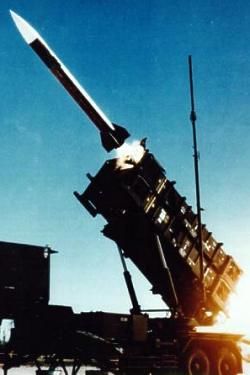
Home - Search - Browse - Alphabetic Index: 0- 1- 2- 3- 4- 5- 6- 7- 8- 9
A- B- C- D- E- F- G- H- I- J- K- L- M- N- O- P- Q- R- S- T- U- V- W- X- Y- Z
Patriot
 Patriot Credit: via Andreas Parsch |
AKA: MIM-104. Status: Active.
The Patriot surface-to-air missile was designed to replace both the Hawk and Nike Hercules in US Army inventory. Subject to continuous improvement, 21st Century models had anti-ballistic missile capability.
Studies began in 1961 and Raytheon was selected as prime contractor in May 1967. First test launches began in November 1969. Full scale development was delayed to January 1976 by a switch to track-via-missile guidance in order to improve accuracy and decoy discrimination. It was not until 1984 that the Patriot began to deploy with Army units. Patriot is boosted by a single solid-propellant rocket motor and armed with a high-explosive blast-fragmentation warhead detonated by a radar proximity fuse. The missile is transported, loaded, and launched from a canister. Four of these are loaded onto a towed launching station. Mid-course guidance is inertial with command updates. Terminal guidance uses semi-active radar, with command updates based on track-via-missile data downlinked to the ground computer. A single G-band pulse-Doppler phased-array radar replaces the multiple radars of earlier Army SAMs.
Later versions and updates of the Patriot included:
- MIM-104B deployed in the late 1980s, with standoff jammer countermeasure capability. This allowed the missile to home on surface jammers while retaining surface-to-air capability.
- PAC-1 with anti-tactical ballistic missile capability. This was tested in September 1986 and deployed in July 1988.
- PAC-2 with an improved warhead, new proximity fuse, and greater anti-missile capability. This was deployed in 1990 and achieved international notice when used against Iraqi Scud missiles in 1991.
- PAC-2-GEM with better performance against stealthy targets, and an improved fuse for high-speed ballistic missiles. This was deployed in 1995.
- PAC-3, a three-step upgrade, with many changes to ground and missile systems, including Link 16 JTIDS to communicate with other battlefield systems, and improved capability against stealth and anti-radiation targets, and improved target discrimination in cluttered radar environments.
- PAC-3 ERINT, a completely new missile optimized for the anti-missile role and using hit-to-kill instead of an explosive warhead. Four ERINTs can be launched from the same canister as a single earlier Patriot.
Initial Operational Capability: 1982.
More at: Patriot.
| MIM-104A American surface-to-air missile. Command-guided / semi-active radar-homing. Range 160 km in PAC-1 with software changes. PAC-2 modification with bigger warhead. |
| PAC-3 American anti-ballistic missile. In EMD. PAC-3 version has limited Theater Ballistic Missile Defense capability. |
| ERINT American anti-ballistic missile. Extended-Range Interceptor, Patriot improvements, SDIO/BMDO project |
Family: surface-to-air, vehicle-launched. Country: USA. Agency: Raytheon .
Back to top of page
Home - Search - Browse - Alphabetic Index: 0- 1- 2- 3- 4- 5- 6- 7- 8- 9
A- B- C- D- E- F- G- H- I- J- K- L- M- N- O- P- Q- R- S- T- U- V- W- X- Y- Z
© 1997-2019 Mark Wade - Contact
© / Conditions for Use